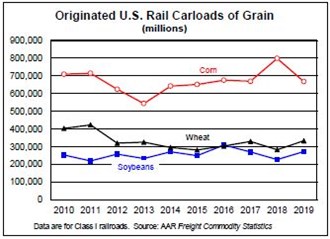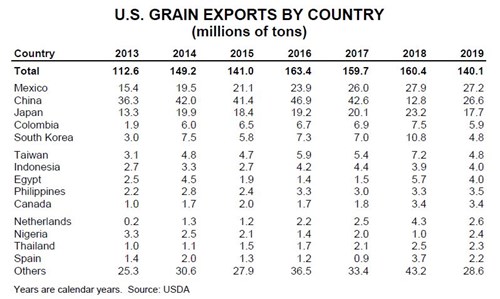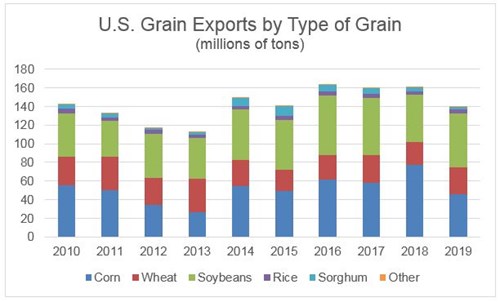
COVID-19 has disrupted nearly every sector of the economy and freight rail is no exception. Non-essential commodities are historically the hardest hit during recessions. Staples for daily life, however, remain somewhat insulated from the economic storm. Grain is an essential commodity that remains in demand regardless of economic conditions.
The four primary grain categories transported by freight rail in North America are corn, wheat, canola and soybeans. Grains are used not just as food for humans, but also for animal feed and refined into ethanol for fuel. Below is a graph of the relative sizes of each key grain product in the U.S. as reported by the Association of American Railroads (AAR).
Although Canada transports about half as much grain by rail as the U.S., it is still an important commodity for Canadian railroads. Both Canadian National (CN) and Canadian Pacific (CP) transported all-time record amounts of grain during Q1 2020 and through May.


Domestic consumption and intra-North American trade provides farmers with a strong demand base for grain. Trade between the U.S., Canada and Mexico was further streamlined by the final ratification of the USMCA agreement in March 2020. For U.S. producers of corn, wheat and soybeans, export markets overseas are also a constant driver of demand. The U.S. has diverse trading partnerships and even when trade negotiations faltered with China in 2018, U.S. grain exports still increased from the prior year.


Covered hopper railcar design takes several factors about grain into consideration, such as product density, angle of repose and shipper takeaway capacity. Product density refers to the pounds per cubic foot of a commodity, while the angle of repose refers to the natural slope formed by a commodity when it is piled. Without factoring the natural angle of repose, a shipper is left with unused, wasted capacity in the top corners of a covered hopper. In some cases, the stated capacity of a covered hopper may be much greater than what is utilized due to a commodity with a steep or shallow angle of repose.
The key grains transported by freight rail in North America can be further broken down into five varieties of corn, six varieties of wheat, canola, soybeans and soybean meal. This diversity is why Greenbrier has a suite of covered hoppers for all sorts of grain and grain-related products. The product density and angle of repose determine the size and shape of the covered hopper, while the shipper takeaway capacity determines the optimal gate design. Currently, the grain industry is served by shippers with a variety of unloading infrastructure capabilities and takeaway speeds. Greenbrier’s innovative Tsunami Gate™ is a powerful solution for this market due to its ability to meter the flow of grain during unloading. Varying the speeds of unloading to match whatever shippers can accommodate ensure that takeaway operations are not overwhelmed and that excess product does not cause any safety issues.
If you or your end customer are unsure of the commodity features you are hauling, the Greenbrier team can recommend the right capacity covered hopper with the optimal unloading system for you. Contact us today to start the process.
Find out more about Greenbrier’s grain covered hopper offerings and how our team is building the future of rail.
Additional resources:
https://apps.fas.usda.gov/psdonline/circulars/grain.pdf
https://www.ers.usda.gov/topics/crops/wheat/wheat-sector-at-a-glance/
https://grainscanada.gc.ca/en/grain-quality/grain-grading/wheat-classes.html
https://grainscanada.gc.ca/en/grain-research/statistics/exports-grain-wheat-flour/

